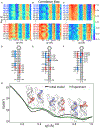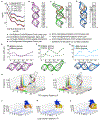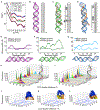Insights into the structural stability of major groove RNA triplexes by WAXS-guided MD simulations
- PMID: 35936555
- PMCID: PMC9351628
- DOI: 10.1016/j.xcrp.2022.100971
Insights into the structural stability of major groove RNA triplexes by WAXS-guided MD simulations
Abstract
RNA triple helices are commonly observed tertiary motifs that are associated with critical biological functions, including signal transduction. Because the recognition of their biological importance is relatively recent, their full range of structural properties has not yet been elucidated. The integration of solution wide-angle X-ray scattering (WAXS) with molecular dynamics (MD) simulations, described here, provides a new way to capture the structures of major-groove RNA triplexes that evade crystallographic characterization. This method yields excellent agreement between measured and computed WAXS profiles and allows for an atomically detailed visualization of these motifs. Using correlation maps, the relationship between well-defined features in the scattering profiles and real space characteristics of RNA molecules is defined, including the subtle conformational variations in the double-stranded RNA upon the incorporation of a third strand by base triples. This readily applicable approach has the potential to provide insight into interactions that stabilize RNA tertiary structure that enables function.
Conflict of interest statement
DECLARATION OF INTERESTS The authors declare no competing interests.
Figures








Similar articles
-
Understanding nucleic acid structural changes by comparing wide-angle x-ray scattering (WAXS) experiments to molecular dynamics simulations.J Chem Phys. 2016 May 28;144(20):205102. doi: 10.1063/1.4950814. J Chem Phys. 2016. PMID: 27250330 Free PMC article.
-
The structural plasticity of nucleic acid duplexes revealed by WAXS and MD.Sci Adv. 2021 Apr 23;7(17):eabf6106. doi: 10.1126/sciadv.abf6106. Print 2021 Apr. Sci Adv. 2021. PMID: 33893104 Free PMC article.
-
Validating solution ensembles from molecular dynamics simulation by wide-angle X-ray scattering data.Biophys J. 2014 Jul 15;107(2):435-447. doi: 10.1016/j.bpj.2014.06.006. Biophys J. 2014. PMID: 25028885 Free PMC article.
-
Unraveling the structure and biological functions of RNA triple helices.Wiley Interdiscip Rev RNA. 2020 Nov;11(6):e1598. doi: 10.1002/wrna.1598. Epub 2020 May 22. Wiley Interdiscip Rev RNA. 2020. PMID: 32441456 Free PMC article. Review.
-
New approaches toward recognition of nucleic acid triple helices.Acc Chem Res. 2011 Feb 15;44(2):134-46. doi: 10.1021/ar100113q. Epub 2010 Nov 12. Acc Chem Res. 2011. PMID: 21073199 Free PMC article. Review.
Cited by
-
Small-Angle X-ray Scattering (SAXS) Combined with SAXS-Driven Molecular Dynamics for Structural Analysis of Multistranded RNA Assemblies.ACS Appl Mater Interfaces. 2024 Dec 11;16(49):67178-67191. doi: 10.1021/acsami.4c12397. Epub 2024 Nov 26. ACS Appl Mater Interfaces. 2024. PMID: 39593218 Free PMC article.
-
Sampling globally and locally correct RNA 3D structures using Ernwin, SPQR and experimental SAXS data.Nucleic Acids Res. 2024 Sep 9;52(16):e73. doi: 10.1093/nar/gkae602. Nucleic Acids Res. 2024. PMID: 39021350 Free PMC article.
-
RNA structures and dynamics with Å resolution revealed by x-ray free-electron lasers.Sci Adv. 2023 Sep 29;9(39):eadj3509. doi: 10.1126/sciadv.adj3509. Epub 2023 Sep 27. Sci Adv. 2023. PMID: 37756398 Free PMC article.
-
Atomistic structure of the SARS-CoV-2 pseudoknot in solution from SAXS-driven molecular dynamics.Nucleic Acids Res. 2023 Nov 10;51(20):11332-11344. doi: 10.1093/nar/gkad809. Nucleic Acids Res. 2023. PMID: 37819014 Free PMC article.
-
Revealing the Solution Conformation and Hydration Structure of Type I Tropocollagen Using X-ray Scattering and Molecular Dynamics Simulation.Biomacromolecules. 2025 Jan 13;26(1):449-458. doi: 10.1021/acs.biomac.4c01261. Epub 2025 Jan 2. Biomacromolecules. 2025. PMID: 39746152
References
Grants and funding
LinkOut - more resources
Full Text Sources
